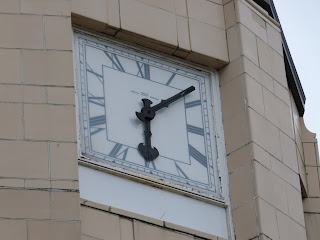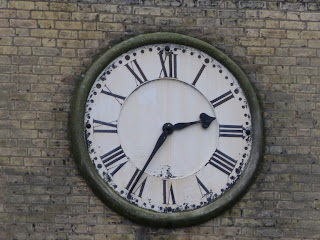It's nearly two months since my last posting, and I've got several trips that are just sitting there on my camera still. So my New Year's resolution has to be to get back out on some trips, and to deal with the backlog.
Let's start with a new trip on New Year's Day. I've seen a painting of West Ham church (by G Thornber, 1893 - any one got any details of the artist?) which shows it as a hotch potch of building styles, so a trip to the real thing seemed like a good idea.
Most of London is usually quiet on New Year's Day as no life-long British resident would expect either public transport or museums and galleries to be up and running. And why waste the time when you could be shopping in Bluewater or Lakeside or one of the Westfield centres for more things you don't need at prices you could pay at many other times in the year?
But of course I forgot about the New Year's Day parade, now in its 30th year. So a quiet visit to the Royal Academy in Piccadilly turned into a battle through the crowds with ears assaulted by marching bands from across the world. Hey ho.
So it was with some relief to get on to the Jubilee line for the trip to West Ham, noting on the way that there is a new tube map cover design out (by Tomma Abts - winner of the Turner Prize in 2006 [was it really that long ago?]).
Anyway, emerging at West Ham station, you are greeted with the site of a simple but visually pleasing brick clock tower.
I am somewhat a fan of the simple hands and numbers on a plain brick wall type clock, even more so when it has no nonsense Arabic numerals. You know where you are with this sort of clock, and where you are is West Ham which is no nonsense sort of place.
Onwards along Manor Road to my primary destination - look, there up ahead is West Ham parish church of All Saints.
The church is originally from 1180, but has all sorts of alterations, additions and restorations over the centuries. The tower, for example, was added in the 15th century.
According to the church's website (
www.westhamchurch.org.uk), Charles Dickens used to set his watch by the time on the church clock. As well he might, for the clock gave the true time on New Year's Day.
Although Charles Dickens might have difficulty setting his watch by the sun dial which has lost its gnomen. Does anyone know the particular significance of 1803?
But see what I mean by the hotch potch of architectural styles:
Let's press on to Stratford rather than retrace our steps to West Ham. Which gives us a chance to pass this building on the corner of West Ham Lane and Mark Street.
I am not sure what this building was originally, but I think it might be offices of the TGWU.
On now to The Broadway, Stratford, and the Church of St John.
The church was built in 1833, and the clock of 1834 is by Benjamin Lewis Vulliamy.
Stratford bus station looks rather lovely when it is lit up as darkness and general gloom descends at 3 o'clock. And look carefully in the distance, for there you will spy a clock (which is not surprising as this is a blog about clocks, albeit with the occasional other diversion).
The usual Transport for London clock, but simple and elegant nonetheless.
And from the right angle has a sort of modern take on Art Deco about it:
In the railway station next door there are two identical clocks on the interior of the south-facing wall.
This is the one above the entrance from the bus station, the other is over the entrance to the DLR part of the railway station.
And with that its time to take the train home.


















































































